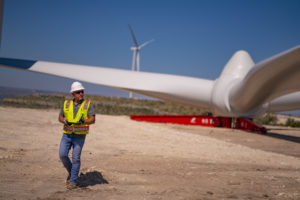NREL scenarios project huge growth in solar/wind, lower emissions, more tax credits


David Buskirk, electrical supervisor at the High Lonesome wind farm (during construction), Texas. The photo was taken in August 2019. (Courtesy: Enel)
The National Renewable Energy Laboratory (NREL) has released its 2023 Standard Scenarios, which aim to show how the U.S. electricity sector might change through 2050. Think crystal ball, but with way more math. If you flip its 74 pages of full-color PDF glory (or skip to its key takeaways), you’ll find NREL anticipating potentially massive growth in wind and solar deployments, electricity sector emissions decreasing “significantly,” and clean energy tax credits persisting.
The Standard Scenarios is one of several annually updated NREL products designed to support decision-makers in the U.S. electricity sector. Every year, NREL uses its Regional Energy Deployment System (ReEDS) model to create the aforementioned scenarios, taking into account the latest projections for technology costs and performance from NREL’s Annual Technology Baseline. Now in its ninth installment, the Standard Scenarios includes 53 possible futures. Not Dr. Strange levels, but pretty impressive since this is the real universe and not the Marvel Universe.
“The goal of the Standard Scenarios is to give an annually updated picture of where the U.S. electric grid may be headed,” said Pieter Gagnon, NREL grid researcher and lead author of the Standard Scenarios. “The report and accompanying data sets give users an understanding of what might get built, what associated greenhouse gas emissions may be, and how much it might all cost- across a wide range of possible futures.”
Every year, the Standard Scenarios include a scenario called the Mid-case that serves as a baseline or middle-ground scenario to reflect what might happen if current trends and conditions continue. The Mid-case has central values for model inputs like technology and fuel costs and how much electricity people use. In addition, the Mid-case represents currently enacted electric sector policies. Like the 2022 scenarios, this year’s Standard Scenarios includes provisions in the Inflation Reduction Act of 2022.
This year’s Mid-case shows that by 2050 wind and solar power could grow significantly. By 2050, wind and solar make up a significant portion of new electricity generation, with wind reaching 750 GW and solar reaching 1,100 GW. That is a five-time and 10-time increase from current levels, respectively. Natural gas capacity also continues to expand. In the Mid-case, natural gas capacity increases by 200 GW under current policies and 130 GW under the 95% power sector emissions reduction scenario, which is largely driven more by the need for firm capacity than generation.
The Mid-case (I don’t understand why we’re capitalizing it but everyone seems to be doing it and peer pressure is a weakness) also includes currently nascent technologies like natural gas with carbon capture, coal with carbon capture, hydrogen combustion turbines, and small nuclear reactors. These technologies play a limited role under current policies, contributing less than 1% of total electricity generation in the Mid-case scenario. However, currently, nascent technologies play a bigger role in decarbonized futures with breakthrough cost and performance improvements or national electric sector carbon dioxide (CO2) emissions constraints.
Across all scenarios, the U.S. electricity sector emissions decrease significantly through the mid-2030s. The annual U.S. electricity-sector CO2 emissions in 2035 decrease by 81% in the Mid-case and 71%–86% across all scenarios with current policies (relative to emissions in 2005).

While significant, these emissions reductions are not sufficient to phase out the Inflation Reduction Act’s clean energy tax credits, NREL says. Those credits in IRA are scheduled to phase out at the end of 2032 or when national electric sector greenhouse gas emissions drop below 25% of the level in 2022—whichever occurs later. In 13 of 17 scenarios with current policies and no additional decarbonization policies, the emissions threshold is never passed, and the clean energy tax credits therefore persist through 2050. I don’t know about you, but that doesn’t sound great to me!
In the Mid-case, 95% net decarbonization by 2050 is achieved with only a 0.5% increase in present-value bulk electric sector costs. One-hundred percent net decarbonization by 2035 increases costs by 14%.
Compared to the 2022 edition, NREL says the “most impactful” changes in the 2023 scenarios are materially higher electricity demand projections (with many regions becoming winter-peaking), higher costs for interconnecting renewable generators to the grid, the introduction of growth penalties, the inclusion of electricity-produced hydrogen, as well as the general updating of fuel and technology cost
projections.



